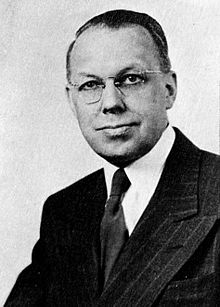Ernest L. Wilkinson | |
|---|---|
 Wilkinson pictured in The Banyan 1952, BYU yearbook | |
| President of Brigham Young University | |
| In office February 1951 – July 1971[1] | |
| Preceded by | Howard S. McDonald |
| Succeeded by | Dallin H. Oaks |
| Personal details | |
| Born | May 4, 1899 Ogden, Utah, U.S. |
| Died | April 6, 1978 (aged 78) Salt Lake City, Utah, U.S. |
| Alma mater | George Washington University |
Ernest Leroy Wilkinson (May 4, 1899 – April 6, 1978) was an American academic administrator, lawyer, and prominent figure in the Church of Jesus Christ of Latter-day Saints (LDS Church). He was president of Brigham Young University (BYU) from 1951 to 1971, simultaneously overseeing the entire LDS Church Educational System (CES). He is credited with the expansion of BYU. Under his presidency, the student body increased six times to over 25,000 students due to the university's physical growth and his aggressive recruiting policies; the number of colleges at the university increased from five to thirteen, and the number of faculty members increased four-fold. Wilkinson focused on recruiting more faculty and convincing current faculty to receive education outside the university. As a result, the number of teachers with doctorate degrees increased from 50 to 500. Associate and doctoral programs were created for BYU.
The J. Reuben Clark Library (now the Harold B. Lee Library (HBLL)) was built, and library resources were expanded by 500%. The number of buildings on the BYU campus increased from 6 to over 300, an increase in floor space of about 4.2 million square feet. Wilkinson initiated the construction of various student housing options to accommodate over 6,000 students, and increased the number of student religious congregations. During his 20-year presidency, the number of congregations increased from 1 student branch to 98 wards and 10 stakes for LDS students. The BYU Honor Code was also more clearly established, and a strict dress code was added.
Wilkinson was a strongly conservative Republican. He unsuccessfully ran for the U.S. Senate in 1964, while he was president of BYU. Prior to his career in education, he was a lawyer in Washington, D.C. and New York City, his most well-known and lucrative case being a $32 million settlement from the U.S. government for the Ute Indian Tribes.
- ^ Bergera & Priddis 1985, p. 22